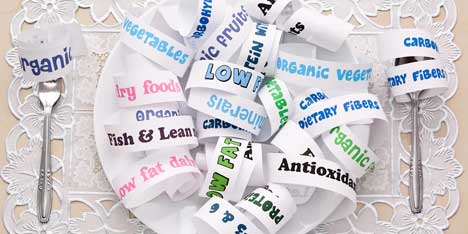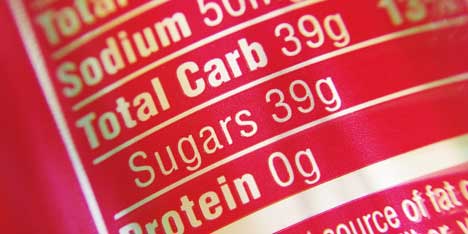Reading Food Labels
As consumers have become more nutrition aware, packaged food manufacturers are now actively marketing their products to health conscious shoppers. Packaged foods are often adorned with claims of their healthfulness and nutritional balance.
But such claims are part of marketing, and marketing is at best very selective information. A healthy dose of skepticism, and knowing what to look for, will help you make better choices in the supermarket.
As consumers have become more nutrition aware, packaged food manufacturers are now actively marketing their products to health conscious shoppers. Packaged foods are often adorned with claims of their healthfulness and nutritional balance.
But such claims are part of marketing, and marketing is at best very selective information. A healthy dose of skepticism, and knowing what to look for, will help you make better choices in the supermarket.
The Law
Food labeling is regulated by the Department of Agriculture (USDA), the Food and Drug Administration (FDA), and the Federal Trade Commission (FTC).
But regulations leave a lot of wiggle room, and there is no law against half truths.
Food labeling is regulated by the Department of Agriculture (USDA), the Food and Drug Administration (FDA), and the Federal Trade Commission (FTC).
But regulations leave a lot of wiggle room, and there is no law against half truths.
"Low Fat/Sugar/Sodium"
Good news: these food label claims may have some meaning. There is a non-binding FDA recommendation of what these claims mean. Note that this is not a regulation, but a recommendation. "Low Fat" means less than 3 grams per serving, "Low Sodium" means less than 140 mg, "Low Cholesterol" means less than 20 mg. There is no FDA recommendation for "Low Sugar".
Of course, even if this claim is solid, it still does not mean that the food is healthy or nutritionally balanced. Check the rest of the Nutrition Facts panel. If the food is labeled "Low Fat", it could still be high in sugar, and so on. Also check the serving size. Sometimes the serving size is so small that a regular person would typically eat several so-called servings in one go, which of course means that you consume more fat, sodium, cholesterol, or sugar than what was used for the claim.

"Reduced Fat/Sugar/Sodium"
These claims are vague at best. Reduced compared to what? The FDA recommends (and like the "low" claims, this is non-binding) that "Reduced something" means 25% less of that nutrient than a reference food. But the FDA does not specify what that reference food should be.
"No Added Sugar"
The claim that a food has "No Added Sugar" does not mean that the food is low in sugar or low in calories. Especially in the case of fruit juices, watch out for the sugar content.
The claim that a food has "No Added Sugar" does not mean that the food is low in sugar or low in calories. Especially in the case of fruit juices, watch out for the sugar content.

"90% Fat Free"
Translation: "10% Fat"
Translation: "10% Fat"
The Nutrition Facts Panel
Q: What is the most important number on a Nutrition Facts panel? Fat? Sugar? Sodium?
A: Without the Serving Size, the other values on the panel have no meaning. The most important number on the Nutrition Facts panel is the Serving Size.
In the United States, all packaged foods are required to display a Nutrition Facts panel. The FDA regulates the layout, the size, the nutrients that must be listed, and the serving size.
However the serving size regulation is open to interpretation. And importantly, the serving size may or may not be the amount that you would normally consume. So before you read the rest of the panel, check the serving size, estimate how much you would eat, and put your math cap on.
The serving size of Kellogg's Frosted Flakes is 3/4 cup. Have you ever put 3/4 cup of flakes in your bowl? It would barely cover the bottom. And if you eat more than the indicated serving size, you will have to do a little math when you read the rest of the Nutrition Facts panel.
Another example, the nutrition panel on the back of a 20 oz bottle of VitaminWater lists 13 grams of sugar. So are there only 13 grams of sugar in that handy little bottle that fits so nicely in your gym bag? Look closer and put your glasses on. The serving size is only 8 oz. So there are 13 grams of sugar... in every 8 oz. The bottle contains 20 oz, so it has 32 grams of sugar. That is a significant amount.
Q: What is the most important number on a Nutrition Facts panel? Fat? Sugar? Sodium?
A: Without the Serving Size, the other values on the panel have no meaning. The most important number on the Nutrition Facts panel is the Serving Size.
In the United States, all packaged foods are required to display a Nutrition Facts panel. The FDA regulates the layout, the size, the nutrients that must be listed, and the serving size.
However the serving size regulation is open to interpretation. And importantly, the serving size may or may not be the amount that you would normally consume. So before you read the rest of the panel, check the serving size, estimate how much you would eat, and put your math cap on.
The serving size of Kellogg's Frosted Flakes is 3/4 cup. Have you ever put 3/4 cup of flakes in your bowl? It would barely cover the bottom. And if you eat more than the indicated serving size, you will have to do a little math when you read the rest of the Nutrition Facts panel.
Another example, the nutrition panel on the back of a 20 oz bottle of VitaminWater lists 13 grams of sugar. So are there only 13 grams of sugar in that handy little bottle that fits so nicely in your gym bag? Look closer and put your glasses on. The serving size is only 8 oz. So there are 13 grams of sugar... in every 8 oz. The bottle contains 20 oz, so it has 32 grams of sugar. That is a significant amount.

